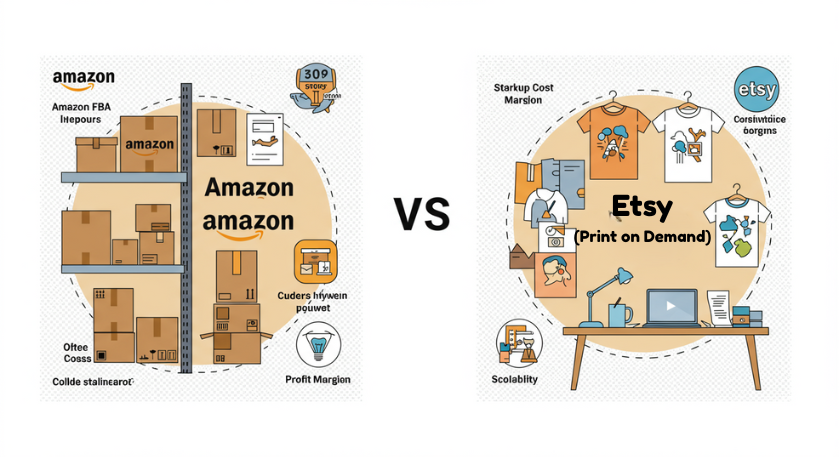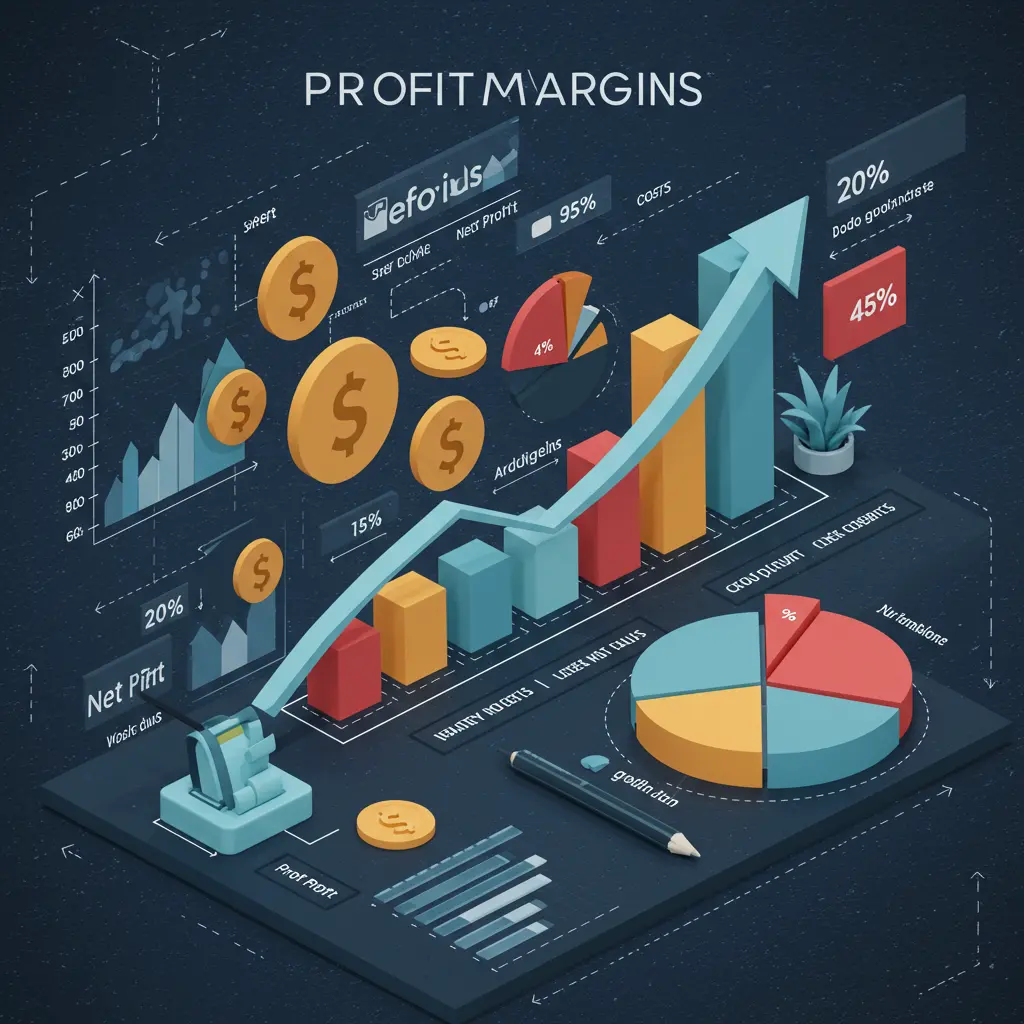In the world of eCommerce, two popular models stand out for aspiring entrepreneurs: Amazon FBA (Fulfillment by Amazon) and Etsy Print on Demand (POD).

Both offer unique advantages but choosing the right one depends on your goals, products and business style. Let’s break down the key differences, pros, cons and help you decide which model is right for you.
Business Model Overview
Amazon FBA
Amazon FBA (Fulfillment by Amazon) enables vendors to keep their goods in Amazon’s warehouses.When a customer places an order, Amazon handles the packaging, shipping, customer service and even returns. It’s ideal for entrepreneurs who want to sell physical products without managing their own inventory or logistics.
With access to Amazon Prime shipping and a massive customer base, sellers can boost their sales significantly. However, there are storage fees and upfront investment involved. Still Amazon FBA is considered one of the best and most scalable eCommerce models for building a long term, trusted online business.
- You source or manufacture products in bulk and ship them to Amazon’s warehouses.
- Amazon handles storage, packing, shipping and customer service.
- Best for private label products, wholesale or arbitrage.
Etsy Print on Demand
Etsy Print on Demand (POD) is a low risk eCommerce model where you sell custom designed products like T. shirts, mugs, posters and more without holding any inventory. When a customer places an order on your Etsy shop, a third party POD provider (like Printful or Printify) prints the product and ships it directly to the buyer.
This model is perfect for artists, graphic designers and creatives who want to turn their art into sellable items. However, profit margins can be lower and shipping times depend on the POD provider. Still it’s ideal for passive income and creative freedom.
Amazon FBA vs. Etsy Print on Demand
Startup Costs & Fees
| Factor | Amazon FBA | Etsy Print-on-Demand |
| Initial Investment | Higher (inventory + shipping costs) | Lower (only design & listing costs) |
| Monthly Fees | Amazon seller fees (~$40/month) | Etsy listing fees ($0.20 per item) |
| Fulfillment Fees | Storage + fulfillment fees apply | Included in POD supplier’s pricing |
Profit Margins

Amazon FBA: Profit Margins:
Amazon FBA ka profit margin typically ranges between 10% to 30%, depending on product type, sourcing cost and competition. Sellers with low product costs and high demand can earn higher margins.
However, Amazon charges fees for storage, fulfillment and referral which reduce profits. Proper pricing, niche selection and cost control are key to maximizing FBA profit margins.
Etsy POD: Profit Margins
Etsy Print on Demand (POD) profit margins typically range from 15% to 25%, depending on product pricing and the costs charged by POD providers. Since production, packaging and shipping are handled externally, the margins are lower than traditional selling. To boost profits, sellers focus on unique, high demand designs, niche targeting and pricing strategies that highlight the value of custom, creative products.
Competition & Market Saturation
Amazon FBA: Competition & Market Saturation:
Amazon FBA faces intense competition due to its massive seller base and product variety. Many niches are highly saturated, making it challenging for new sellers to stand out without strong branding, unique products or competitive pricing.
Ranking on Amazon also requires keyword optimization and marketing spend. However, high traffic and global reach offer great potential if you can differentiate your product effectively.
Etsy POD: Competition & Market Saturation:
Etsy POD also has growing competition, especially in popular categories like T.shirts and mugs. However since Etsy favors creative and unique products, sellers with original designs and niche targeting can still succeed. Personalized and custom made items perform well.
While saturation exists, artistic style and branding play a major role in standing out and building a loyal customer base.
https://www.wemakewebsites.com/blog/amazon-vs-etsy-a-comparison-for-merchants
Scalability

Amazon FBA: Scalability:
Amazon FBA is highly scalable. Once your product is listed and selling, you can easily increase inventory and expand to new markets using Amazon’s global fulfillment network. Amazon handles storage, packing, shipping and customer service, making it easier to manage large volumes.
With proper supply chain management, marketing and automation tools, sellers can grow from small businesses to full fledged brands. However scaling also increases fees and requires careful profit monitoring.
Etsy POD: Scalability:
Print on Etsy Since production and delivery are handled by third party POD providers, demand may be increased with little effort. You don’t have to hire employees or maintain inventory as orders grow.
Adding more designs, focusing on new markets or branching out to different platforms are ways to grow. However POD expenses may continue to restrict profit margins. For Etsy to grow sustainably, branding, SEO and constant design quality are crucial.
Which Should You Choose?
Choose Amazon FBA If You…
- Have capital for inventory.
- Want to sell generic or trending products.
- Prefer a hands-off fulfillment process.
Choose Etsy Print-on-Demand If You…
- Are a creative with unique designs.
- Want low startup costs and no inventory risk.
- Prefer a niche audience (e.g., personalized gifts).
Conclusion:
Amazon FBA and Etsy Print on Demand (POD) offer two distinct paths for starting an online business. Amazon FBA is ideal for those who can invest upfront and want to scale a physical product based brand using Amazon’s fulfillment services, though it comes with higher fees and intense competition. In contrast, Etsy POD is perfect for creatives and beginners due to its low startup costs, minimal risk and hands off fulfillment process but it offers lower profit margins.
Both models are scalable FBA through inventory expansion and global reach and Etsy POD through creative product variety and niche targeting. Ultimately, your choice should depend on your available capital, business goals and whether you prefer managing products or focusing on design.
Q: What’s the main difference between Amazon FBA and Etsy POD?
A: Amazon FBA involves selling physical products stored and shipped by Amazon while Etsy POD allows you to sell custom designed products that are printed and shipped by a third party provider after a customer places an order.
Q: Which platform offers better profit margins?
A: Amazon FBA generally provides higher profit margins (10–30%) if managed well while Etsy POD margins are lower (15–25%) due to production and fulfillment charges by POD partners.
Q: Which business model is easier to scale?
A: Both models are scalable. Amazon FBA can scale through inventory expansion and automation, while Etsy POD scales creatively by adding new designs and targeting different niches without managing inventory.
Q: How do I choose between Amazon FBA and Etsy POD?
A: Choose Amazon FBA if you have capital to invest and want to build a large product based brand. Choose Etsy POD if you are a creative individual looking for a low risk, design focused business with passive income potential.